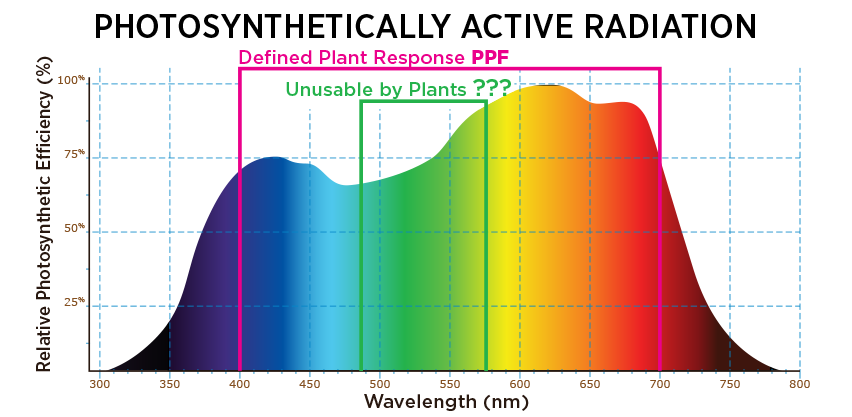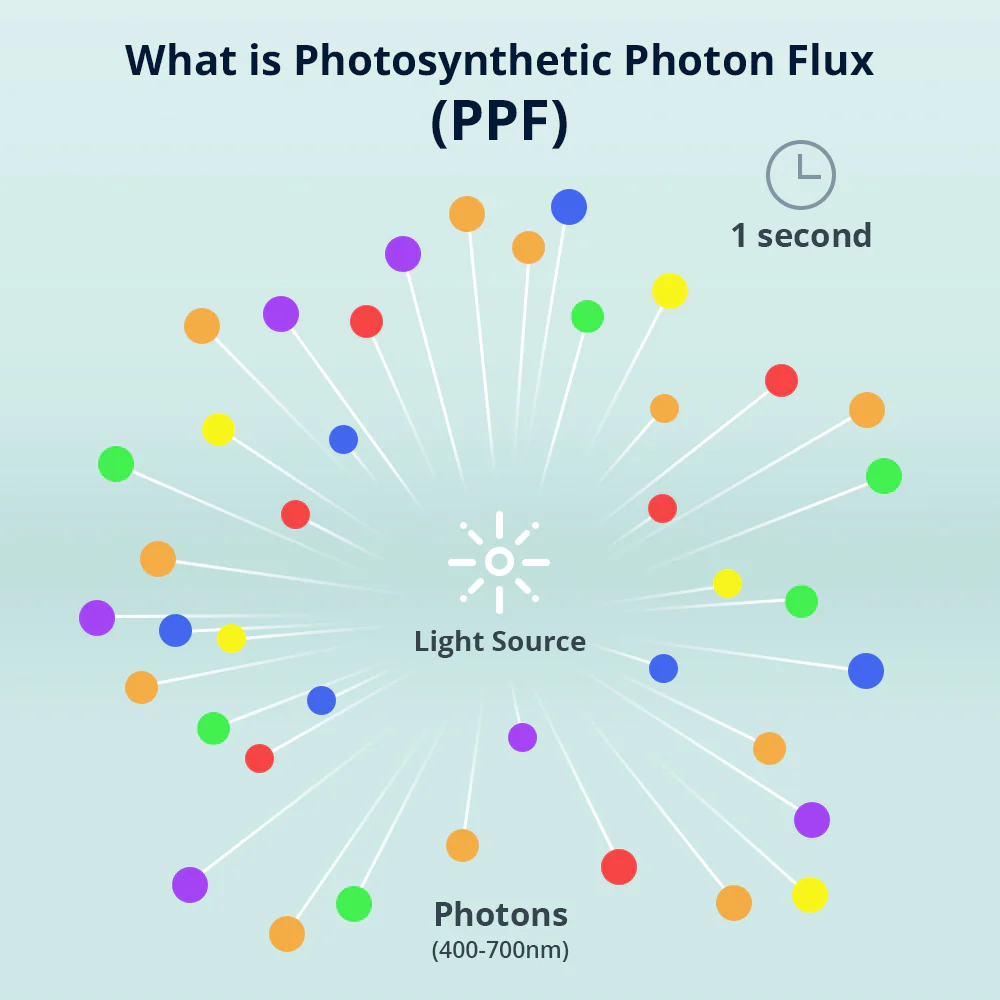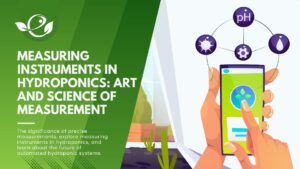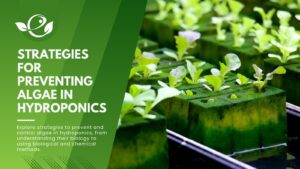Table of Contents
As LED technology revolutionized the field of plant lighting, traditional metrics like lumens and lux became inadequate for determining optimal light requirements. Instead, terms like PAR, PPF, PPFD, and DLI have emerged as crucial measurements in the realm of photosynthetic lighting applications. This article aims to clarify these terms, dispel common misconceptions, and empower growers with the knowledge to determine appropriate light levels for vibrant and thriving plants. Let’s delve into the science behind these concepts and explore how they can guide growers in their quest for optimal plant growth.
Understanding PAR: The Essence of Photosynthesis
PAR, or Photosynthetically Active Radiation, is a widely used term that is often misunderstood. Unlike traditional measurements like feet or kilos, PAR does not represent a specific unit of measurement. Instead, it refers to the specific type of light, known as electromagnetic radiation, that is essential for supporting photosynthesis in plants. During photosynthesis, plants convert light energy into chemical energy, which fuels their growth and overall well-being.
It is intriguing to note that plants primarily utilize the same part of the light spectrum that is visible to the human eye. However, the wavelengths of light that we perceive as the brightest, such as green light, are not necessarily the most efficient for photosynthesis. Scientists categorize different types of light based on their wavelengths, which collectively form the electromagnetic radiation spectrum. This spectrum encompasses various forms of light, including X-rays, radio waves, infrared light (invisible to the human eye), as well as visible light such as sunlight, and light emitted by red or blue LEDs.

Therefore, it is important to understand that PAR itself is not a measurement but rather represents the portion of the electromagnetic radiation spectrum that is beneficial for activating photosynthesis in plants and algae. The measurements that truly matter when selecting a lighting system or fixture to promote photosynthesis are PPF, PPFD, and DLI.
The Vital Measurements in Grow Light: PPF, PPFD, DLI, and Moles
When selecting a lighting system for stimulating photosynthesis, three crucial measurements come into play: PPF, PPFD, and DLI. Understanding these metrics is essential for determining the light output, light availability, and overall light exposure your plants will receive.
Photosynthetic Photon Flux (PPF):
PPF measures the total amount of light emitted by a light source per second. It quantifies the photosynthetically active photons generated by a lighting system. Scientists and light engineers express PPF in micromoles per second (μmol/s). Notably, PPF does not account for how much of the emitted light actually reaches the plants or any specific surface. While it is the second most important measurement for lighting systems, many manufacturers surprisingly fail to provide this information.

Photosynthetic Photon Flux Density (PPFD):
PPFD measures the amount of light that actually reaches the plants or algae. It is a spot measurement denoting the number of photosynthetically active photons falling on a given surface per second. PPFD is expressed in micromoles per square meter per second (μmol/m²/s). By assessing PPFD, growers can determine the light intensity their plants receive at specific locations within the canopy.
Daily Light Integral (DLI):
DLI represents the total amount of light delivered to a plant throughout a day. Think of it as the plant’s daily “dose” of light. DLI measures the cumulative number of photons reaching the plants or algae during the daily photoperiod. Scientists express DLI in moles per square meter per day (mol/m²/d). It serves as the most crucial metric for determining the overall growth rate of plants and algae. By understanding the preferred DLI for specific plants, growers can design lighting systems that provide the required light dosage.
Moles:
In the context of measuring light, moles are used to express vast quantities of photons or “light particles.” A mole is equal to Avogadro’s number, an enormous figure amounting to 602,214,150,000,000,000,000,000. To facilitate more manageable calculations, scientists utilize micromoles, which represent one-millionth of a mole. In simpler terms, a micromole of photons is equivalent to 602 quadrillion.
Simplifying the Concepts: Raindrops from a Cloud
To better comprehend the interplay between these measurements, an analogy can be drawn between light and rain, and the light fixture and a cloud. Consider PPF as the number of raindrops falling from a cloud per second. Imagine a cloud producing one million raindrops per second; if it spans the size of Texas, you might not even perceive the rain outside.
However, if the cloud were car-sized, standing underneath it would be a drenching experience. Similarly, PPF reveals the number of photons emitted by a lighting fixture per second, while PPFD represents the density of raindrop-like photons landing on a one-meter square target (plants or algae) per second. The analogy highlights the importance of PPFD in determining the actual light exposure received by plants.
Definitions Recap:
Photosynthetically Active Radiation (PAR):
The type of light necessary for photosynthesis is not a measurable metric.
Photosynthetic Photon Flux (PPF):
Total light emitted by a light source per second, measured in micromoles per second (μmol/s).
Photosynthetic Photon Flux Density (PPFD):
Light that reaches the target per second, measured in micromoles per square meter per second (μmol/m²/s).
Daily Light Integral (DLI):
Cumulative light delivered to the target during a day, measured in moles per square meter per day (mol/m²/d).
Mole:
A scientific term equal to Avogadro’s number, representing an immense quantity.
Micromole:
One-millionth of a mole or 602 quadrillion.
Photons:
Particles of light.
Photoperiod:
The duration of light availability for promoting photosynthesis in plants each day.
Wrap up
As LED grow lights revolutionize plant cultivation, understanding the concepts of PAR, PPF, PPFD, and DLI is crucial for maximizing plant growth and health. By grasping these measurements, growers can select appropriate lighting systems, optimize light distribution, and ensure plants receive the required light dosage. This knowledge empowers growers to provide their plants with the ideal environment for photosynthesis, leading to thriving and vibrant greenery.
| Know more about “How to Choose the Best LED Grow Light for Your Plants“ |








